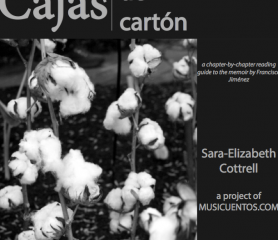2013’s second most popular post offers tips for those of us approaching the new world language AP exams.
The world of AP World Language teachers is all abuzz with the vast changes made to the exams this year. Six years ago the Spanish language exam changed to what was a more proficiency-based format. Last year other exams changed to move toward and past what the Spanish exam was, and for 2014 the Spanish exam will change to meet them. Thus, every AP Spanish teacher in the country is submitting a new syllabus through the course audit to get College Board approval.
The most recent changes do not seem to be terribly significant for the Spanish exam. The biggest one to me is that there are no sources to read, listen to, or cite for the presentational speaking task. This is a positive, intuitive change in my opinion. The requirements for the task were far too in-depth for a two-minute prep time leading to a two-minute speaking sample. (See the recent post on what I think the AP exam measures. Also check out the popular post Dear novice-learner teacher – love, an AP teacher)
With a newborn, a baby age 1, and a preschooler age 4, I have been on hiatus from professional development this year, including any AP Spanish workshops. So I’m asking and relying on other teachers who have been to the workshops to pass along to me what they have learned. One such teacher is Cristy Vogel, a fellow #langchat moderator, who recently blogged what she learned from the AP French workshop. Read her post and then see my comments below. Then help us out – do my opinions bear out in your experience? Do you have additional tips you’ve learned?
- Memorize directions.
Indeed. If students already know the directions, they can spend more valuable time previewing questions and answers to prime themselves for comprehension or examining sources. - Focus on content.
This is a proficiency move. Students cannot think that they can simply throw language out there and score high. They have to show analysis, synthesis, and critical thinking. I thought it was particularly interesting that Cristy’s workshop suggested essays of 5+ paragraphs seem to score higher. - Push opinions.
This is a change for the AP Spanish exam. Opinions were important before, but it’s even more important now for students to show that they can take a stand and defend it on… well, any issue. - Vary your sources.
I’m glad to see a greater variety of sources used in AP courses. I knew this change was coming and so this past year we did a lot more work with, for example, blog posts, tweets, and infographics. - Bring in cultural information.
This has been on the Spanish language rubric for all free-response questions since the last change. However, the language in the rubric for what this means is terribly vague, and many high-scoring samples on the website have no noticeable cultural references. So, it’s still a guess as to what they want here. My advice to students was to cite cultural information from sources with an opinion added on sourced tasks. On the interpersonal tasks, 1) in writing create a situation that lends itself to showing some cultural knowledge, like your grandmother is in a Cuban neighborhood in Miami if you’re writing to your grandmother (who writes to their grandmother in Spanish?!), and 2) in speaking they will set up a situation designed for you to insert cultural information, like asking for categories (music! drop lesser-known names like Fonsi and Jesse y Joy!). - Use idiomatic expressions.
I give my students a document of idioms that we practice using. They know they cannot score “advanced” on my vocabulary section of the rubric unless I see at least one idiomatic expression. Favorites in my class are “no veo la hora,” “para nada,” “para colmos,” and “al fin y al cabo.” - Use culturally appropriate letter conventions.
We refer to the Oxford document on these conventions. - A score of 1 means…
I have no idea. This is one of my major problems with the AP. Like I wrote in my previous post, I have had a functionally proficient student score a 1. It is no reflection on language ability. It is completely a reflection of test-taking ability and critical thinking skills like analysis and synthesis of sources. It infuriates me that my students can work hard and answer every question in the target language and get a score that equates them with someone who answers half in English and leaves half the questions blank. - Elaborate instead of listing.
As in, instead of giving examples which looks like just pushing the word count – like “I visited France, Spain, Italy, and Greece” – elaborate on what happened in one in particular. (I think?) I thought this was a super interesting tip. I’ll be holding on to that one. - Kick the English transfer.
Also known as “Google translate syndrome.” Teachers who push a lot of translation actually foster this problem. It’s better to use more basic language that’s communicative than to try to get complicated and produce a jumbled mess with English structure mapped all over it. - Cite the sources.
For sure. This has been a key on the Spanish exam for a while. I tell my students to plan from the beginning and then double-check that they have integrated well all the sources given (which now only applies to the persuasive essay). It’s better to be a little incorrect on some information (particularly common on the audio source) than to leave it out. - Include a direct quote.
Wow, really? I always thought direct quotes were shallower integration than paraphrases were. No, I know that’s true. But anyway, Cristy heard that you can’t get a 5 without a direct quote on the essay. - Sources are predictable.
I had no idea about this either. She says the first and third source contradict each other and the second one is vague so students can use it for either point of view. Critiquing this vague source and sharing a hypothesis raises the score. - Use transitions!
I push students to begin trying transitional phrases at novice level. This is a big proficiency goal for us. - Compare cultures.
I’ve never been sure about how much students should bring in their own point of view but now I’m sure it’s critical. Talk about how the target culture feels about it. Compare your opinions. Balance your time on the two. Students must compare the two cultures. - Push language.
For a higher score, do something out of the ordinary, particularly in pushing vocabulary, deep critical thinking, supportive arguments, and understanding of the target culture. Students need to show advanced structures, but these structures have never actually been spelled out. Your guess is as good as mine. - Don’t present the topic.
On presentational speaking. This is a new one for me. I’ve always thought it was fine for students to begin with a greeting and tell what they’re going to talk about. Turns out this is taboo now. Good to know. - First complete the task, then show what you can do.
On the speaking tasks – the most important thing is to do what they told you to do. Then, just keep rambling until your time is out (on topic of course). Show what you can do with the language. It’s okay if you’re cut off.
So, there you go. Help! Based on your experiences teaching AP Spanish and attending the workshops this summer, what should we expect in the new exam? Are we on track here?
Along that train of thought, keep an eye out this school year for the first Musicuentos eBooks coming available, many directly related to teaching AP or any advanced Spanish class.
2 Comments
Comments are closed.




Thank you, thank you!! My students have been completing “fluency activities” for the last two years and it has helped them tremendously.(they’ve actually said so!!) With lyricstraining some have used Spanish songs as their ring tone. really cute!
I appreciate your new list & will be using it. Happy New Year!!
Happy New Year to you too, and I’m glad the update is helping you!